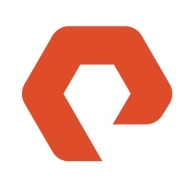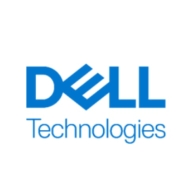


NetApp AFF and Dell Unity XT are two competitive storage solutions. NetApp AFF holds an edge in performance, but Dell Unity XT shines in scalability and comprehensive features.
Features:NetApp AFF reviews commend its lightning-fast performance, seamless cloud service integration, and efficient data management. Dell Unity XT receives positive feedback for robust scalability, advanced data services, and flexible storage options.
Room for Improvement:Users suggest NetApp AFF could benefit from a more intuitive configuration process, improved support documentation, and a better UI. Dell Unity XT could enhance its data migration tools, streamline patch updates, and improve maintenance functionalities.
Ease of Deployment and Customer Service:NetApp AFF is praised for straightforward deployment but needs better guidance and support during initial setup. Dell Unity XT is recognized for ease of deployment in large-scale environments and responsive customer service.
Pricing and ROI:NetApp AFF users find the initial setup costs to be high but justify it with excellent long-term ROI due to superior performance. Dell Unity XT users appreciate competitive pricing and quick return on investment, citing the product's extensive features.
If you wait more than seven years to buy another one, you get a return on your investment.
Customers always have their issues resolved promptly.
Technical support is good at least through vendors, not directly with the principal.
The support team is familiar with the product and is available on-site during support times, which improves our experience.
Dell solutions are backed by excellent service and support.
The technical support sometimes takes three to four days to get hardware to facilities.
The support for NetApp AFF is comprehensive—not just the documentation for self-guided reading, but for simple questions, spare parts, or urgent needs, you can have a contract that enables delivery the next business day or within four hours, depending on your process requirements.
I have communicated with them, and they are effective and responsive.
It is highly scalable.
It hasn't broken down anytime in the last six to seven years, despite hurricanes, earthquakes, and power outages.
Dell Unity XT is quite scalable and can be scaled up to the petabyte level.
For NetApp, we can recommend the FAS 8000 series.
You can add more disks, more disk shelves, or migrate the data seamlessly.
I would assess the scalability of NetApp AFF as excellent in handling massive data volumes.
I would rate the stability of the product at seven out of ten.
I would rate the overall stability of Dell Unity XT an eight out of ten.
They have always been upgrading very fast and implementing patches to resolve these issues.
We would appreciate a built-in transparent failover in the next release to eliminate the need for a separate metro cluster.
One way to improve the product is to add an operational assistant that doesn't depend on VMware.
I would like to see some AI features that would allow arrays to intelligently identify threats or unusual behavior in the data pattern and give an alert.
In the future, if Dell storages include this option, especially for Unity, it would help us target SME or medium enterprises for quicker closures and support the sales team.
I believe if Dell can integrate AI to predict potential failures, especially in hardware like hard disks, that would be very useful for proper maintenance.
The pricing is a bit higher than expected.
The GUI of ONTAP Command Manager could be better, but the CLI is perfect.
Our backup system, Commvault, has an amazing capacity to do compression and deduplication better than NetApp AFF by itself.
All of this is the same for all product ranges, whether E-series, NetApp AFF, or FAS series, because they are very efficient to respond.
While the prices may be higher than those of other vendors, we see it as a market leader with benefits.
The support can be a bit pricey, but the solution is more cost-effective than anything else out there.
I would rate the solution as an eight out of ten in terms of costliness.
It is priced at around or under $50,000.
The cost is not cheap nor expensive.
Commercially, Dell Unity XT is viable and competitively priced.
NetApp support is cheaper than Dell support.
While it is not cheap, they have introduced a new series of AFF that are more affordable.
The licensing cost of the product is expensive, and when combined with support, it becomes quite costly.
Its data compression feature is the best that we have ever seen.
The standout features for us in Pure FlashArray X NVMe are its robust DDoS protection, seamless transparent failover, and failback capabilities ensuring high availability.
Pure FlashArray X NVMe helps to improve our processing speed.
Dell Unity XT integration with VMware helps scalability and availability through seamless operations and enhanced performance.
It helps with data cost management and is seen as a mid-range product with good performance.
We installed the Flash, which makes our IO operations fast and efficient.
You can even download the ONTAP simulator and deploy it on your virtualization platform and test almost all features.
Data reduction capabilities such as deduplication, compression, and compaction are standard features included with the license in NetApp AFF.
They have 4:1 data reduction techniques, which is really very high. If you have a size of 100 terabytes, you will get 400 terabytes of usable capacity when applying compression, deduplication, or other data reduction technologies.
| Product | Market Share (%) |
|---|---|
| NetApp AFF | 8.8% |
| Dell Unity XT | 5.8% |
| Pure FlashArray X NVMe | 1.4% |
| Other | 84.0% |


| Company Size | Count |
|---|---|
| Small Business | 15 |
| Midsize Enterprise | 11 |
| Large Enterprise | 12 |
| Company Size | Count |
|---|---|
| Small Business | 62 |
| Midsize Enterprise | 49 |
| Large Enterprise | 94 |
| Company Size | Count |
|---|---|
| Small Business | 45 |
| Midsize Enterprise | 47 |
| Large Enterprise | 242 |
Pure Storage FlashArray//X is the world’s first enterprise-class, all-NVMe flash storage array. It represents a new class of storage – shared accelerated storage, which is a term coined by Gartner – that delivers major breakthroughs in performance, simplicity, and consolidation.
Dell EMC Unity XT is one of the best all-flash storage arrays on the market today. Dell EMC Unity XT arrays are designed for performance, optimized for efficiency, and built for a multi-cloud world. In addition, they support digital transformation, enabling businesses to reach the full potential of their data capital quickly and easily. Dell EMC Unity’s All-Flash and Hybrid Flash storage platforms provide the performance, efficiency, enterprise-class software, and virtualization integrations required for running a wide range of virtualized applications.
Dell EMC Unity XT Features
Dell EMC Unity XT has many valuable key features, including:
Dell EMC Unity XT Benefits
Some of the benefits of using Dell EMC Unity XT include:
Reviews from Real Users
Below are some reviews and helpful feedback written by Dell EMC Unity XT users.
A Systems Engineering Manager at a manufacturing company says, "It is definitely one of the most robust, solid, well-performing products that I have dealt with. It is set it and forget it, which is pretty amazing." He also mentions, “We can do both block and file storage on one unit without purchasing a separate device.”
Peter S., Senior Technical Specialist at a healthcare company, states, “The most valuable feature is reliability. At the end of the day, it just runs. This solution is easy to work with and easy to maintain.”
PeerSpot user Melvin T., Senior Systems Engineer at Prosperity Bank, explains that the solution is “easy to use and we can add LUNs or space without interruption to end-users. We're able to access it from just about anywhere, as long as we have access to a browser. That feature is really neat because sometimes we will go to a different data center or a different site, and if we need to access it to see a LUN or to see any type of storage, we can do that. That's one of the big takeaways with Unity."
The NetApp A-Series and C-Series are AFF storage arrays that deliver high performance, scalability, and simplified data management for a wide range of workloads. They are designed for organizations that need to improve the performance and agility of their applications, while also reducing costs and complexity.
NetApp A-Series and C-Series feature a scale-out architecture that can be scaled to meet the needs of your growing business. They also support a wide range of built-in data protection and data security features, including snapshots, replication, disaster recovery, and autonomous ransomware protection.
AFF A-Series all-flash systems deliver industry-leading performance, density, scalability, security, and network connectivity.
AFF C-Series systems are suited for large-capacity deployment as an affordable way to modernize your data center to all flash and also connect to the cloud.
NetApp AFF Benefits
NetApp AFF Features
Reviews from Real Users
NetApp AFF stands out among its competitors for a number of reasons. Two major ones are its high performance and simplicity. PeerSpot users take note of the advantages of these features in their reviews:
PeerSpot user and Storage Administrator, Daniel Rúnar Friðþjófsson, comments “AFF has helped to simplify our infrastructure, while still getting very high performance for our business-critical applications. Having all these things working well on one solution is really good. We run this as the backbone for both Hyper-V and VMware as well as an archive location for Rubrik. So, it is great having one solution that can do it all.
Because of the ease of it all, you have a highly tunable, high-performance storage system that alleviates a lot of problems. With its ease of management, you can quickly get your work done and go onto the next thing on your list.”
Additionally, Mohan Reddy, Sr. Technology Architect at a Pharma/Biotech company comments on how “NetApp's ONTAP data management software has also made tasks simpler for us. There's no question about that. It has helped us run operations very quickly, saving us a lot of time. Before ONTAP, we used to spend a long time doing regular operations, but with the latest version of the tool, our day-to-day operations are much quicker and easier.”
We monitor all All-Flash Storage reviews to prevent fraudulent reviews and keep review quality high. We do not post reviews by company employees or direct competitors. We validate each review for authenticity via cross-reference with LinkedIn, and personal follow-up with the reviewer when necessary.